Clary sage (Salvia sclarea) Non-Native
Clary sage (Salvia sclarea)
Parts used: aerial portions, seeds, essential oil
Medicinal uses: An antispasmodic and aromatic plant, clary sage is used to treat digestive problems such as gas and indigestion. It is also regarded as a tonic, calming herb that helps relieve menstrual pain and premenstrual problems. Because of its estrogen-stimulating action, clary sage is most when levels of this hormone are low. The plant can therefore be a valuable remedy for complaints associated with menopause, particularly hot flashes.
Cautions: Do not use clary sage during pregnancy (Chevallier 265).
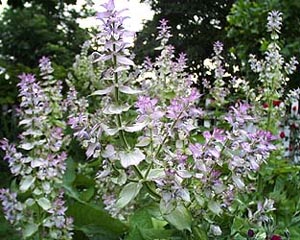
Pacific Northwest Medicinal Plant Guide (Check out all plants growing in Tryon Farm's medicinal garden!)
- Login to post comments



Chrysanthemum, Shungiku (Leucanthemum coronarium) Non-Native
Chrysanthemum, Shungiku (Leucanthemum coronarium)
Parts used: leaves, flowers
Additional uses: Most commonly used as a garland flower. The flowers, leaves, and stems are edible and are often added to soups and stir-fries).
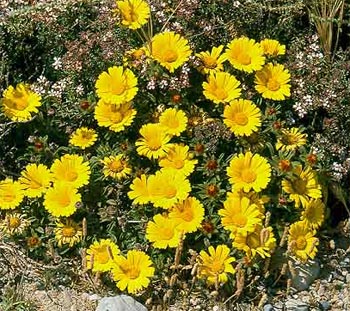
Pacific Northwest Medicinal Plant Guide (Check out all plants growing in Tryon Farm's medicinal garden!)
- Login to post comments



Chicory (Cichorium intybus) Non-Native
Chicory (Cichorium intybus)
Parts used: root, leaves, flowers
Medicinal uses: Dried whole herb used as digestive tonic for loss of appetite and dyspepsia. Traditional choleretic, cholagogue, carminative, diuretic, and “blood purifier.” Syrup is traditional tonic for infants and a cleansing medicine for suffering from rheumatism and gout (Chevallier 189).
Additional uses: As a culinary herb it has a flavor similar to dandelion. The leaves can be eaten fresh or cooked while the root is often roasted and used as either an addition or substitute for coffee (Kowalchik 86-7).
Cautions: None known (Chevallier 189).
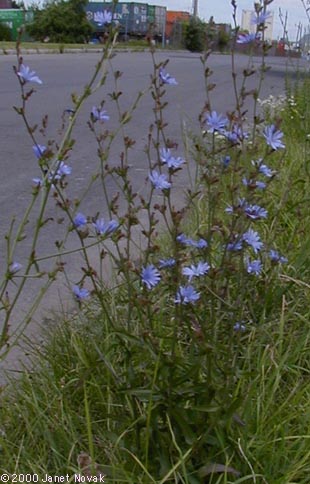
Pacific Northwest Medicinal Plant Guide (Check out all plants growing in Tryon Farm's medicinal garden!)
- Login to post comments



Cherry: (Prunus spp.) Native and Non-Native
Cherry: (Prunus spp.)
Non-native (sweet Cherry) and Native (black Cherry)
Parts used: Sweet: stems, fruit; Black: inner bark
Medicinal uses: Sweet: stems have long been used for their diuretic and astringent properties; have been used for cystitis, nephritis, urinary retention, and gout. Cherries can be used as an overall regimen treating arthritic problems. Their high sugar content makes them mildly laxative. Black: the bark counters dry and irritable coughs; its astringency can also ease indigestion and the symptoms of irritable bowel syndrome, especially when these conditions are of a nervous origin.
Nutritional information: Sweet cherries are a good source of vitamin C and copper. They are also high in flavonoids including anthocyanidins and proanthocyanidins (Murray 265).
Cautions: Sweet: the seeds are toxic and should not be taken internally. Black: the bark is highly toxic in excessive doses (Chevallier 256-7).
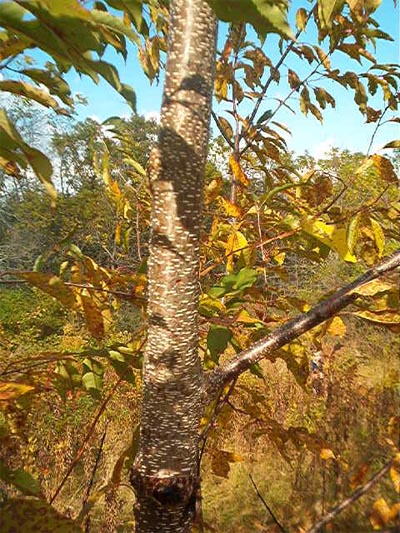
Pacific Northwest Medicinal Plant Guide (Check out all plants growing in Tryon Farm's medicinal garden!)
- Login to post comments



Chamomile (Matricaria recutita) Non-Native
Chamomile (Matricaria recutita)
Parts used: aerial portions
Medicinal uses: Anti-inflammatory, antiseptic. Topically treats inflammations of skin and mucosa, and other skin disorders. Internally treats flatulent nervous dyspepsia, gastritis, diarrhea, travel sickness, and mild anxiety. Volatile oil is inhaled to treat nasal catarrh, inflammation, and irritation of the respiratory tract (Chevallier 80).
Additional uses: With its distinctive apple-like fragrance, chamomile can be used as an aromatic addition to potpourris and dried flower arrangements. As a companion plant, chamomile is believed to contribute to the overall health of a garden. Cucumbers and onions are said to benefit especially as well as most herbs (Kowalchik 81-2).
Cautions: The fresh plant can cause dermatitis. Do not take the essential oil internally unless under professional supervision. Do not use the essential oil externally during pregnancy (Chevallier 80).
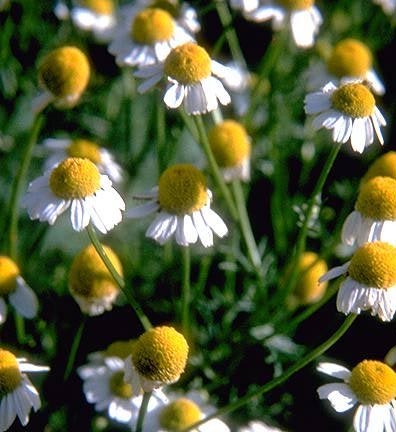
Pacific Northwest Medicinal Plant Guide (Check out all plants growing in Tryon Farm's medicinal garden!)
- Login to post comments



Celandine (Chelidonium majus) Non-Native
Celandine (Chelidonium majus)
Parts used: aerial portions
Medicinal uses: The fresh, toxic aerial parts can be used as a diuretic liver stimulant to treat liver, gallbladder, and digestive pains, as well as jaundice, and to reduce rheumatoid swelling. Externally, the purgative, caustic, orange sap is an ancient remedy for warts, corns, and ringworm.
Cautions: This plant should only be used under the supervision of a qualified practitioner (Bremness 239).
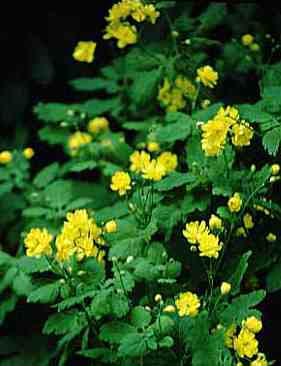
Pacific Northwest Medicinal Plant Guide (Check out all plants growing in Tryon Farm's medicinal garden!)
- Login to post comments



Catnip (Nepeta cataria) and Catmint (Nepeta faassenii) Non-Native
Catnip (Nepeta cataria) and Catmint (Nepeta x faassenii)
Parts used: aerial portions
Medicinal uses: Catnip is settling to the stomach and a gentle sedative. Since it powerfully stimulates sweating, it also reduces fever. Its pleasant taste and gentle action make it a suitable remedy for colds, flu, and fever in children. Catnip is markedly antiflatulent, settling indigestion and colic. It is also useful in treating headaches related to digestive problems. A tincture of the herb makes a good friction rub for rheumatic and arthritic joints, and as an ointment, treats hemorrhoids.
Cautions: Do not take if pregnant (Chevallier 239).
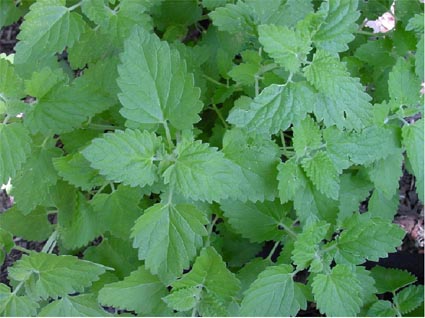
Pacific Northwest Medicinal Plant Guide (Check out all plants growing in Tryon Farm's medicinal garden!)
- Login to post comments



California poppy (Eschscholzia californica) Native
California poppy (Eschscholzia californica)
Parts used: aerial portion
Medicinal uses: Unlike its close relative the Opium poppy, E. californica is not a narcotic, tending to normalize psychological functions rather that disorientating. A gentle antispasmodic, sedative, and analgesic, it is very useful for treating psychological issues in children.
Cautions: None stated (Chevallier 206-7).

Pacific Northwest Medicinal Plant Guide (Check out all plants growing in Tryon Farm's medicinal garden!)
- Login to post comments



Calendula (Calendula officinalis) Non-Native
Calendula (Calendula officinalis)
Parts used: flowers
Medicinal uses: Flower heads and volatile oils used to externally treat slow healing wounds, burns, dry skin, eczema, oral thrush, and hemorrhoids. Taken internally as anti-inflammatory to treat mouth and throat ailments. Improves digestion, stimulates bile production, heals gastric ulcers, and regulates menstrual disorders (Chevallier 73).
Additional uses: The flowers are edible and can be added as a garnish to any food. If dried and ground the flowers can be used as a coloring substitute for saffron or turmeric. Calendula can also be used as a dye plant and to bring out highlights in the hair of brunettes and blondes (Kowalchik 62).
Cautions: None known (Chevallier 73).
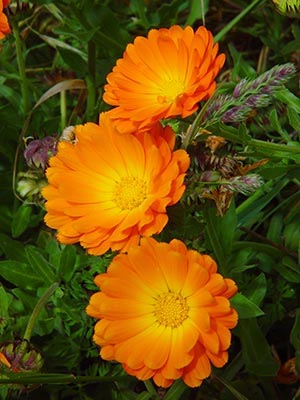
Pacific Northwest Medicinal Plant Guide (Check out all plants growing in Tryon Farm's medicinal garden!)
- Login to post comments



Burdock (Arctium lappa) Non-Native
Burdock (Arctium lappa)
Parts used: root, leaves, seeds
Medicinal uses: Dried roots used to treat gastrointestinal ailments. Root and leaf extracts are used to treat eczema, psoriasis, acne, skin infection, slow-healing wounds, dermatitis, itches, insect bites, and other ailments. Fresh root can be added to stir-fries and soups. Used as an alterative this plant cleanses the blood by cleansing and detoxifying the eliminative organs (Chevallier 65).
Additional uses: Burdock makes an exceptional addition to many foods. The root can be stir-fried, simmered in soups and stews, steamed, or sautéed. Spring leaves of first year plants can be served raw or prepared like spinach (Kowalchik 58-9).
Cautions: None known (Chevallier 65).
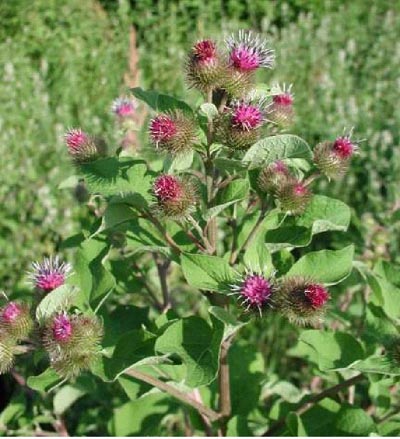
Pacific Northwest Medicinal Plant Guide (Check out all plants growing in Tryon Farm's medicinal garden!)
- Login to post comments



Feedback and participation welcome! Please send bug reports to web@tryonfarm.org








